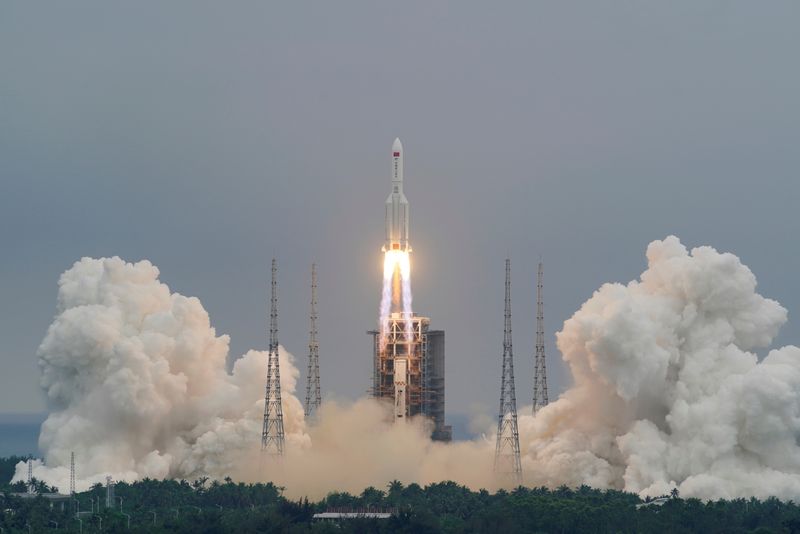By Ryan Woo
BEIJING (Reuters) - China launched into orbit last month the first piece of a permanent space station using its most powerful rocket, but international focus has fallen instead on the re-entry of debris which critics say has been shrouded in secrecy.
WHAT HAPPENED?
The Long March 5B rocket successfully delivered its payload into orbit on April 29, in the first of 11 missions needed to complete China's first permanent space station by 2022.
Media reports warned of an "uncontrolled" re-entry of the rocket's core stage, rekindling memories of debris from the flight of the first Long March 5B in May 2020, which damaged buildings when it landed in Ivory Coast.
Remnants from the rocket finally fell harmlessly in the Indian Ocean on Sunday after a 10-day descent, but China has drawn criticism for not being transparent about the timing of the debris re-entry and predictions of its trajectory.
WHAT DID CHINA SAY?
The China National Space Administration (CNSA) said nothing about the rocket's re-entry until shortly before its arrival on Sunday morning Beijing time, in contrast to normal international practice when initial public announcements can be made days in advance.
"That left foreign observers scrambling to map the discarded heavy stage of the Long March 5B and guesstimate its final destination on Earth," said Richard de Grijs, professor of astrophysics at Macquarie University.
"This caused anxiety to a large number of nations in the potential impact area."
The debris landed in the Indian Ocean near the Maldives and India.
CNSA declined to comment.
Hua Chunying, a spokeswoman for the Chinese foreign ministry, told reporters on Monday that China had shared the results of re-entry predictions through "international cooperation mechanisms," when asked whether the Maldives and India had been informed.
She did not say when the results were shared.
Space-faring nations must minimise the risks to people and property and maximise transparency, and China failed to meet "responsible standards" in both aspects, said NASA.
LITTLE KNOWN
Scientists know little about the rocket itself - including its design for demise.
The core stage was not discarded until its payload - the space station module Tianhe - reached orbit. In contrast, rocket stages typically drop off more quickly, making their landing sites more predictable.
But falling off too quickly could have run the risk of not inserting a huge payload into orbit. The Long March 5B has only one core stage, unlike other rockets with two or even three stages.
"It seems that China's rocket design has prioritised power above all else, that is, enough power to lift heavy payloads to orbit," said de Grijs.
The chances of space junk damaging property and taking human lives are tiny, scientists say, with most burning up in the Earth's atmosphere, but sturdier components can survive.
"(The rocket) was not forced to re-enter and was left to natural processes to remove it from orbit," said Moriba Jah, associate professor in aerospace engineering at the University of Texas.
He said "natural rocket decay should be avoided at all costs" because of the risk that chunks of the rocket could survive the re-entry.
'DEVIATION FROM THE NORM'
The rocket's main stage is about 33 metres long, and has a diameter of 5 metres.
The government gave no official data on its mass, but observers say it weighs about 21 tonnes - heavier than China's two earlier prototype space stations combined - Tiangong-1 and Tiangong-2.
There have been no reports of damage so far from the recently launched rocket.
"In the past year, two of China's Long March 5B rocket stages have not fully burned up on re-entry, so that is a noticeable deviation from the norm," said de Grijs.

Within China, media reports of debris from rocket launches are common.
The Long March 5B is next expected to deliver two other space station modules in May and August next year. Other missions will involve the smaller Long March 7 and 2F rockets.